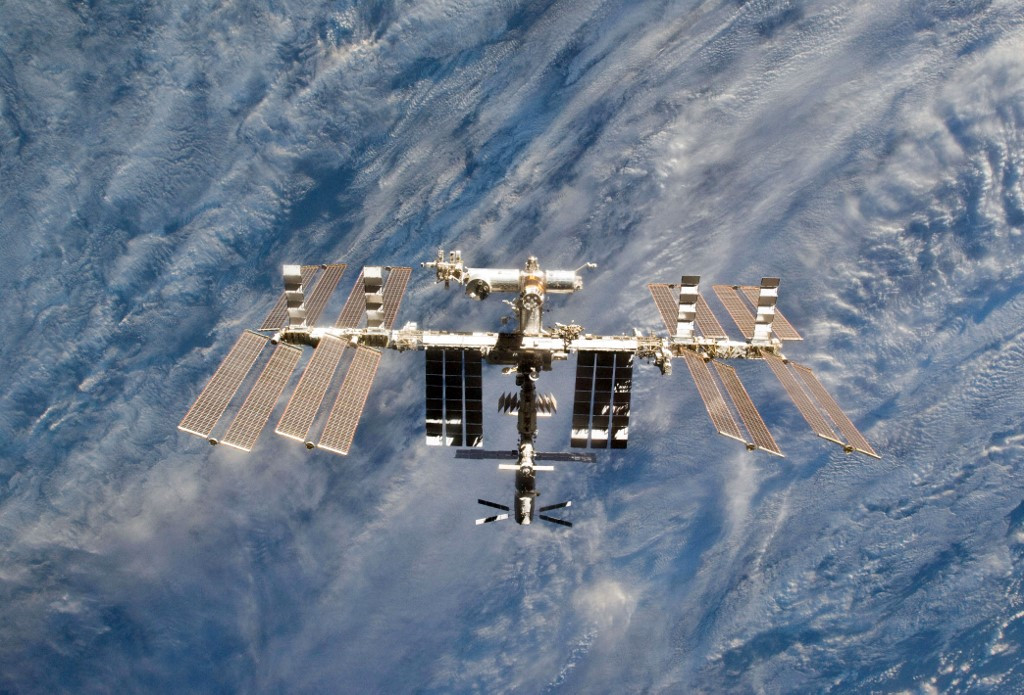Popular Reads
Top Results
Can't find what you're looking for?
View all search resultsPopular Reads
Top Results
Can't find what you're looking for?
View all search resultsRussia satellite destruction put ISS at greater risk
For Didier Schmitt, a senior figure at the European Space Agency (ESA), Moscow's action increased the risk of a collision in space.
Change text size
Gift Premium Articles
to Anyone
 In this file photo taken on March 07, 2011 this NASA handout image shows a close-up view of the International Space Station is featured in this image photographed by an STS-133 crew member on space shuttle Discovery after the station and shuttle began their post-undocking relative separation. The United States said Monday it was investigating a (AFP/NASA)
In this file photo taken on March 07, 2011 this NASA handout image shows a close-up view of the International Space Station is featured in this image photographed by an STS-133 crew member on space shuttle Discovery after the station and shuttle began their post-undocking relative separation. The United States said Monday it was investigating a (AFP/NASA)
R
ussia's destruction of one of its own satellites generated a cloud of debris near the International Space Station (ISS) and its seven-strong crew.
For Didier Schmitt, a senior figure at the European Space Agency (ESA), Moscow's action increased the risk of a collision in space.
Question: Was this a close call for the seven astronauts -- four US, two Russians and a German - aboard the ISS?
Answer: "It's difficult to say with hindsight. But what we know is that from now on, according to our sources, the risk of collision could be five times greater in the weeks, even the months ahead.
"The new debris is moving in the same orbit as the Station, which is to around 400 kilometres in altitude, at more than 8 kilometres a second. That's seven to eight times faster than a rifle bullet! So to avoid them you have to predict a long time in advance: you can raise or lower the ISS a little.
"But to do that, you need a precise cartography of the objects in question, which is not the case because it's all new. We are a bit blind. It is much to soon to decide whether or not to readjust the Station's orbit -- that could make things even worse. The US radars are in the process of doing the calculations to know."
Q: In the meantime, what can the astronauts do? Are they scared?
A: "Yesterday (Monday), the only thing to do was to cross their fingers and take shelter in their respective (escape) capsules. Certain objects passed less than one kilometre away!
"Once the Station had made one circuit of Earth and the cloud had passed, they were able to move back in (to the body of the space station).
"Because of the different alignment of the Earth, the ISS shouldn't pass through the same zone as the debris in the immediate future.
"But obviously the astronauts were scared! They are in a box where the least hole is potentially explosive. And they have no control: it's as if someone told you at home that there was a potential risk of a break-in or a fire, what would you be able to do?"
Q: Does the debris constitute a growing threat? How do you shelter from it?
A: "The great danger of the debris, is the domino effect. The more debris you have, the more chance you have of hitting satellites, and so to blow others up and so on. At these speeds, any impact can be devastating.
"The ISS was built in the 1990s, there was a lot less at that time. And even though the risk of collision has risen, the original structure of the vessel hasn't changed.
"The capsules docked to the ISS are a lot better protected by several layers of aluminium, which mitigates the impact. These capsules moreover being smaller than the ISS (which is as large as a football pitch), the risk of collision is diminished.
"In the event of impact with the ISS, it isn't necessarily the catastrophic scenario of the film "Gravity". The Station is equipped with pressure sensors: if an impact causes a hole in one place, you can isolate one of the modules of the station by closing the airlock. And then you can repair the leaks, as the Russians did on the Mir space station."
"But if the debris hits a fuel tank, then it's serious and it can blow up. But that would really be the height of bad luck!"
"You have to remember that for an astronaut, the main risk is take-off and coming back to Earth. Once you're in orbit, the risk factor is reduced.
"That said, we must not add risk to risk. By attacking the problem from the design stage of satellites, and eliminating existing dangers. This is what ESA does, whose new satellites have a deorbitation system, and a space cleaning program, CleanSpace, a sort of garbage satellite. Unfortunately, there is no regulation at the international level."










